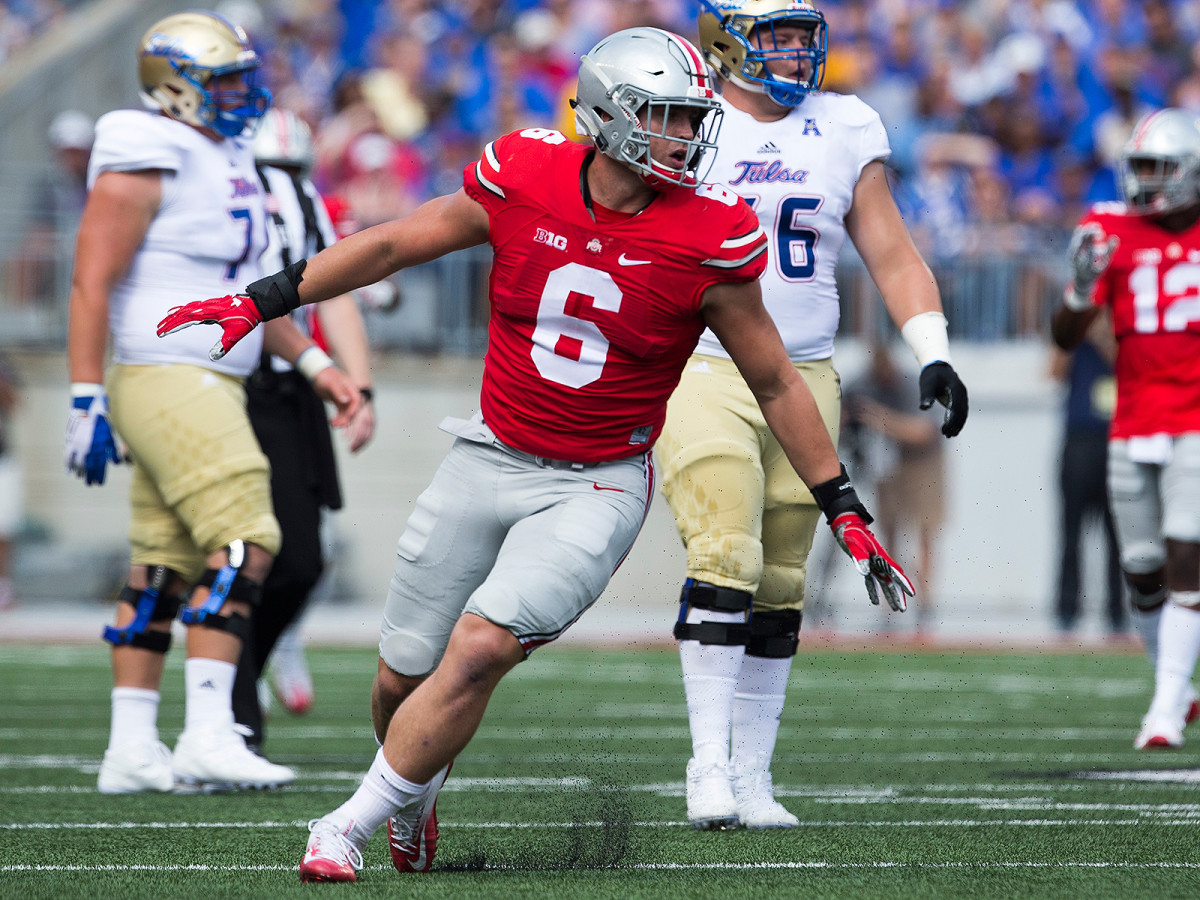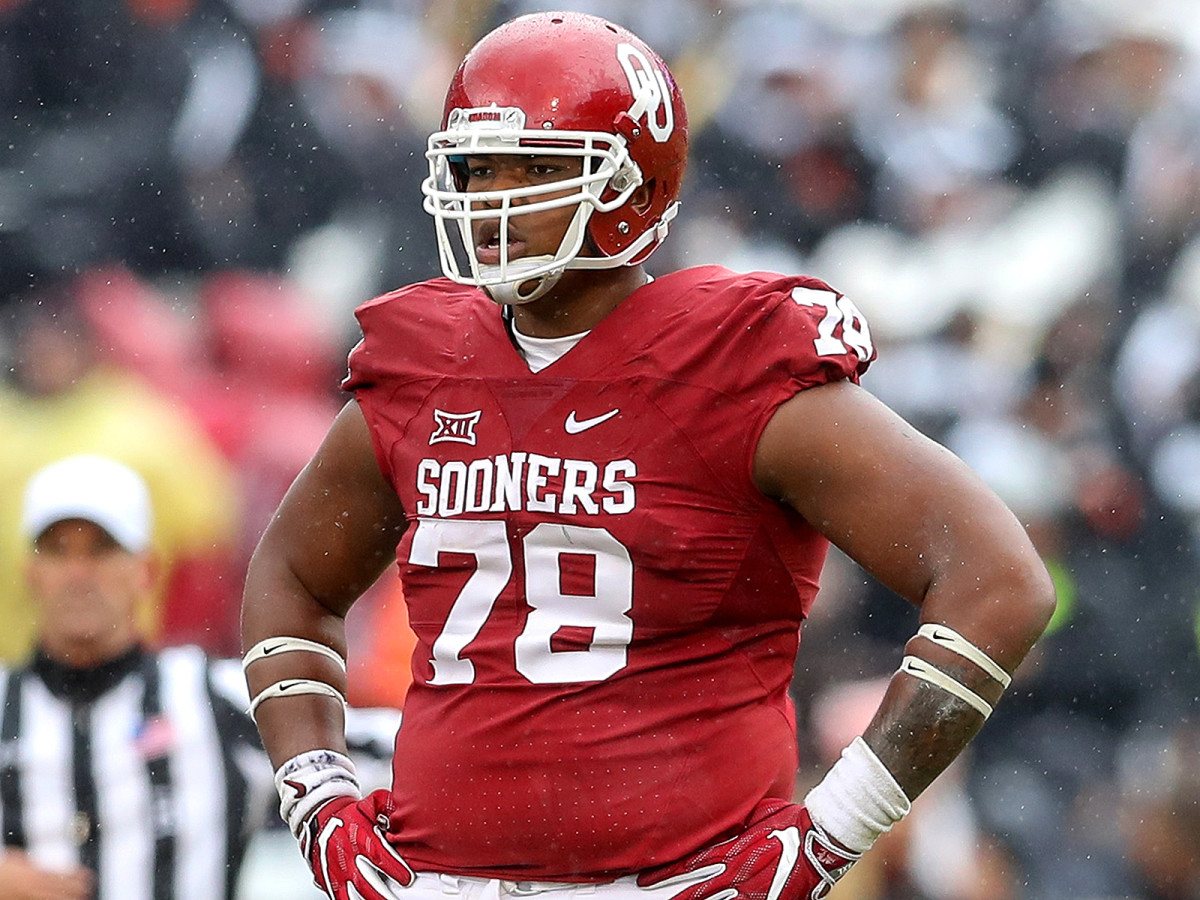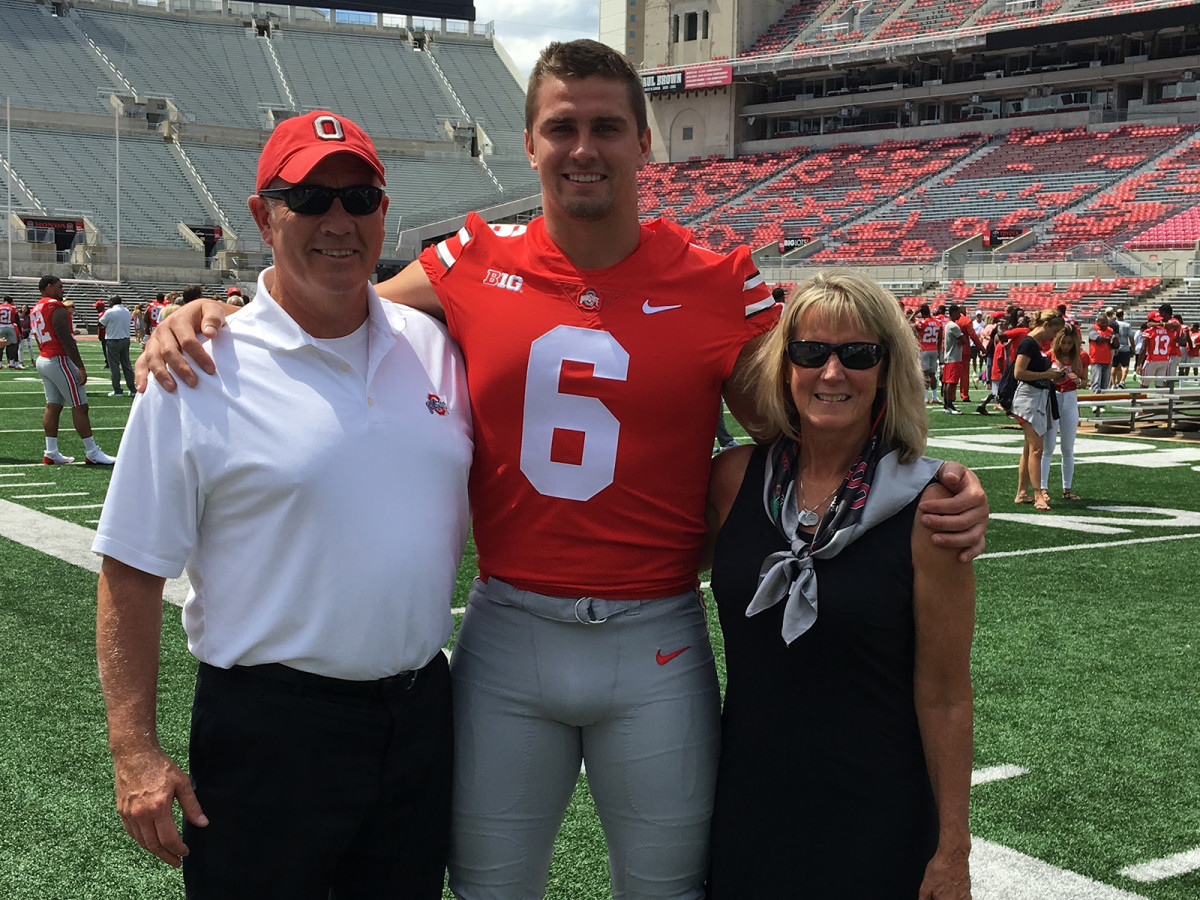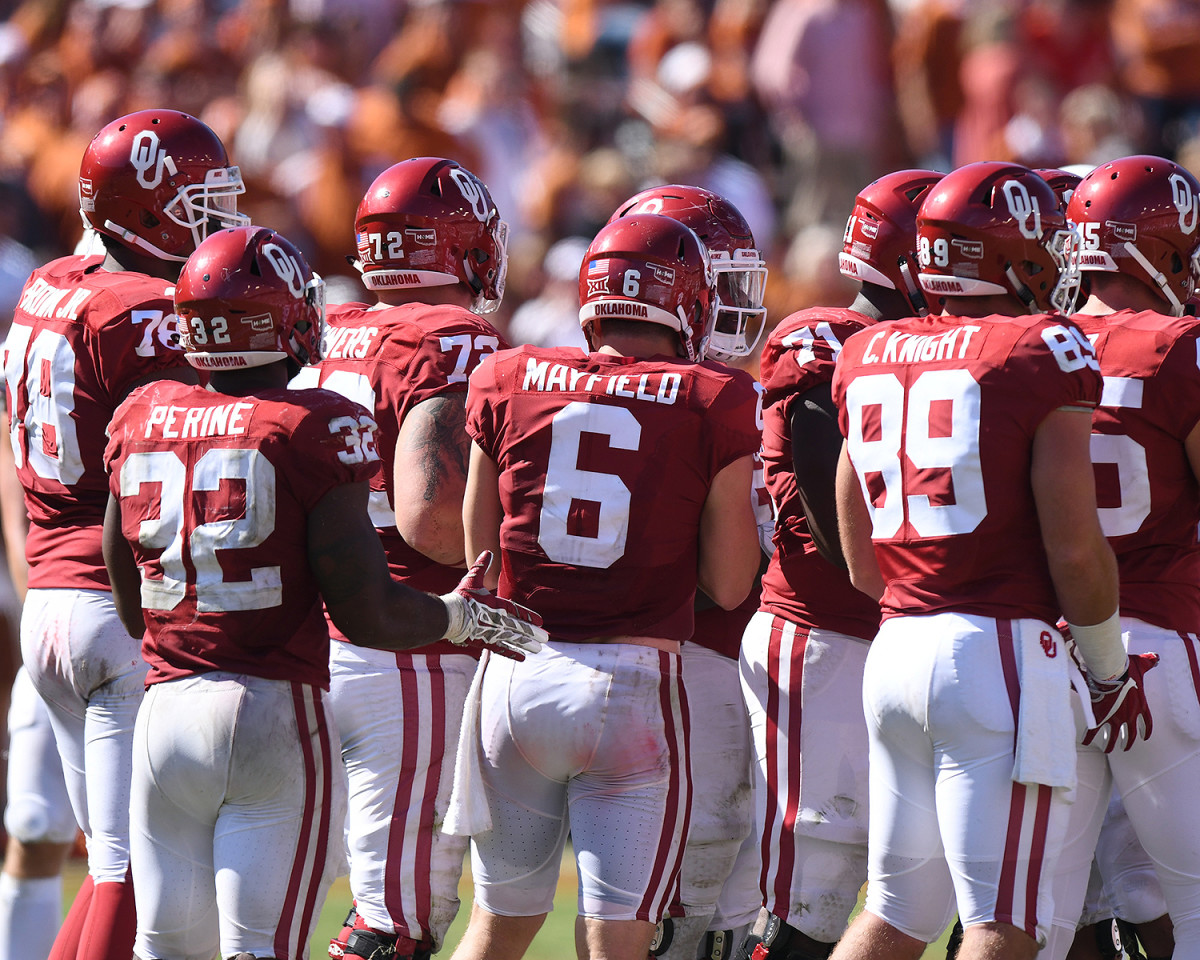How Orlando Brown and Sam Hubbard Came to Tip the Scales of Oklahoma vs. Ohio State

Orlando Brown was a 450-pound eighth-grader who shed 110 pounds between middle school and his redshirt junior year at Oklahoma. Sam Hubbard is a former lacrosse player who has packed 52 pounds onto his frame since arriving at Ohio State. When the Sooners and Buckeyes meet in Columbus in Week 2, the two will collide on the line of scrimmage, and whichever player gets the better of the other could swing one of the most important non-conference games of 2017. Andy Staples (Brown) and Bruce Feldman (Hubbard) tell the stories behind both sides of a matchup that could change the course of the season.
The guy was doing one of those ask-all-the-players-at-media-days-the-same-set-of-wacky questions kind of stories. He had his list, and by God he was going to ask those wacky questions. At one point during Big 12 media days he found himself standing before Orlando Brown, Oklahoma’s 6' 8" offensive tackle.
Q: What song would Brown sing in a karaoke situation?
A: Justin Timberlake’s “Until The End of Time”.
Q: What cartoon character would you want to be?
A: Wile E. Coyote. “I just want to be fast,” Brown said. “But I’m not.”
Q: What advice would you give your younger self?
A: “There’s no need for pizzas at 12 o’clock in the evening,” Brown said. “You’ve got to stay away from the carbs late at night. It’s not worth it.”
With that, Wacky Question Guy wandered away—presumably to learn whether Sooners quarterback Baker Mayfield considers himself more of a Phineas or a Ferb. He should have stuck around for the follow-up questions.
Why would Brown give that advice to his younger self? Because Brown’s younger self stood 6' 4" and weighed 330 pounds in the sixth grade. “I was a couch kid,” he said. “I was in the house playing video games. By eighth grade, Brown had ballooned to 450 pounds. He could find pants that could circumnavigate his waist—but barely. “Destination XL and Casual Male XL make 52-inch waistbands,” said Brown, who will take the field at Ohio State on Saturday weighing 340 pounds and regarded as one of the nation’s best left tackles. “So shoutout to them.”
That was about the time he had called his father crying, begging dad to let him play football. Orlando Brown Sr., who knew a little about football after 10 seasons in the NFL, hadn’t wanted his son to play until high school. The elder Brown relented. Still, the man who was called Zeus while playing offensive tackle for the Browns and Ravens couldn’t bear to see how timid his doughy son was on the field. He threatened to leave the games if the younger Brown didn’t inflict some pain. The younger Brown learned to finish blocks, to play nasty. He also began losing weight. “It’s from actually moving,” he said. “It’s from getting off the couch and sweating. Once I got going, it came off like butter.”
College Football Week 2 Picks: Who Has the Edge in Saturday Night's Busy Slate?
The butter layer was about 70 pounds, Brown surmises. He starred at Maryland powerhouse DeMatha Catholic before his father died in 2011 at age 40. After Zeus passed, the younger Brown and his mother moved to Duluth, Ga. He committed to Tennessee, but academic issues kept him from signing with the Volunteers. (He has no such issues now; Brown has a 3.0 GPA at Oklahoma.) He eventually wound up signing with the Sooners, and he showed up in Norman weighing 380 pounds.
At this point, Oklahoma defensive end Ogbonnia Okoronkwo wants us to stop the story. He isn’t so sure about that 380 number. “Whatever he told you,” Okoronkwo said, “add 10.”
No matter the true number, Brown will never forget that first workout. He missed much of the offseason program as he waited to qualify academically. On his first day in the weight room, Oklahoma strength coach Jerry Schmidt held Brown’s legs as Brown dangled from a pull-up bar. Even with Schmidt’s help, Brown couldn’t raise himself any higher. “I couldn’t do it,” Brown said. “I was just locked out. There was no movement going on. Just sweating.” The pull-up was a pipe dream. “I probably couldn’t do a push-up,” Brown said.
But as soon as Brown learned he would redshirt his freshman season, his attitude changed. He took the advice of former Sooners tackle Jamaal Brown, who suggested Orlando Brown spend that year getting his body in order before he worried about blocking anyone in a game. So Brown came in early to work on flexibility and pass sets. He learned to thrive in Schmidt’s weight room. He also began needing smaller pants.

Let's start with a story about projection. After all, Sam Hubbard does have a 3.6 GPA in finance, a field rooted in projection, and last year he earned Academic All-American honors. But we’re not going to begin with that story. This one actually goes back a lot further, 22 years ago to a doctor’s office in Cincinnati.
The Hubbards had brought little Sammy in for his six-month check-up. The pediatrician examined the baby and told Sam’s mother Amy that her baby boy would grow to be 6' 5" or 6' 6".
“I thought, ‘No way,’” recalled Amy. “Nobody in the family has kids that size.”
Amy is 5' 5". Her husband Jim is 6' 0". Little Sam, the youngest of their three children, now stands 6' 5", 267 pounds, and he has grown into a critical leadership role on what is arguably the nation’s best defensive line. One game into his junior season, Hubbard ranks second among active Buckeyes in career tackles for loss (17) and sacks (11), and his evolution from lacrosse commit to feared defensive end is one of the more intriguing stories in college football.
Hubbard played safety at Cincinnati’s Moeller High, leading the team to two state titles. He also was such a talented midfielder that as a junior he committed to play lacrosse for Notre Dame. That’s where we get into The Dodgeball Story.
Moeller’s football coach, John Rodenberg, was also Hubbard’s gym teacher. One day Ohio State coach Urban Meyer and assistant coach Kerry Coombs walked into Rodenberg’s gym class to say hi. Hubbard happened to be in the class that was playing dodgeball when they arrived.
Meet College Football's Version of the Ball Family
“I remember looking over at this big, athletic kid,” Meyer remembers. “I said to [Rodenberg], ‘Who is that?’”
“Oh, he’s a lacrosse player,” Rodenberg replied. “He’s going to Notre Dame to play lacrosse.”
Hubbard was introduced to Meyer. They shook hands. Hubbard, then 6' 4" and 200 pounds, said he didn’t know that Meyer was watching him.
“I was pretty stuck on playing lacrosse,” Hubbard says. “[Rodenberg] said they want you to come out for a visit. This football thing is really serious. You can play at a high level.”
Hubbard grew up a Buckeyes fan; he and his family went to a couple of Ohio State games every year. “I never thought I’d have an opportunity to play there,” he says. “I couldn’t resist it.”
Hubbard committed to play football for the Buckeyes in April of his junior year. He also decided to not play lacrosse his senior season at Moeller so he could focus on getting bigger and stronger for college football. “He said, ‘I’m so far behind physically, I have to catch up,’ ” his dad Jim says.

Brown learned how to eat. Told when he arrived at Oklahoma that he needed to slim down, he figured he should diet. One day, he went through the buffet line and came out with a piece of chicken and a few leaves of spinach and found himself getting stared down by a 5-foot former Alabama and Nebraska gymnast. “Dude,” Tiffany Byrd said, “I eat more than that.”
Part of Byrd’s job as Oklahoma’s director of sports nutrition is to examine the plates of athletes to ensure they’re eating what they’re supposed to eat. And contrary to what Brown thought, a meal fit for a supermodel wouldn’t help a still-too-hefty offensive tackle. When Byrd sees a player severely restricting his food intake, it sets off alarm bells. Because people who restrict their caloric intake too much almost always eventually binge on unhealthy food. “What are you going to eat later?” Byrd often asks. “Because there’s going to be something else going down.”
Byrd helped Brown learn how to eat the correct food instead of simply limiting his intake. On his least busy day, he needs to consume at least 4,500 calories. “Just to move around that big of a person with that much muscle mass requires a lot of calories,” Byrd said. When Oklahoma is in camp or in the thick of offseason workouts, that daily caloric need can rise as high as 6,500 calories. But that doesn’t mean Brown should wolf down three pizzas. Byrd taught Brown and his teammates how to choose food that will effectively fuel them at the training table, at the grocery store and at restaurants. And Brown listened. He switched from white rice to brown. He switched from white bread to whole grains. He began eating about six smaller meals a day.
When the Sooners appeared at Big 12 media days in Frisco, Texas, they had stopped by Sonic on the drive to the Dallas Cowboys’ training facility. “I’ve got a sandwich and a burrito,” Okoronkwo said. “He’s in the back eating grapes.” Okoronkwo marvels at his teammate’s discipline. “He eats like a bird,” Okoronkwo said. No, he actually eats like a Byrd.

Hubbard’s family hired a personal trainer who set him up on a 5,000-calorie-a-day nutritional plan.
“Every two hours he’d go, ‘What else is there to eat?’ ” Amy Hubbard says. “I felt like I was making food or getting food at the store every two hours. I’d go to Costco and buy the Boost high-calorie shakes. It was like a job.”
Mickey Marotti, the Buckeyes’ Assistant AD for Football Sports Performance, said Hubbard weighed about 215 pounds when he arrived in Columbus. The converted safety was tried at linebacker, then shifted to tight end before being moved to defensive end as he continued to grow into his frame.
“My whole first year I didn’t have any clue how this was gonna play out,” Hubbard says. “I’d go to practice one day and have an offensive jersey. Next day I’d have a defensive jersey. That was tough. I was trying to learn both, making mistakes the entire time, but just going hard all the time was how I got through it, and why I think I earned respect. I just tried to run out there and hit somebody.”
Hubbard redshirted as a freshman during the Buckeyes’ national title run in 2014, practicing in the same position group with All-America Joey Bosa and several other future NFL players. “That was the best thing for me,” Hubbard says. “I’d never played linebacker or defensive line in a game. I was literally standing behind Joey and watching everything he did. That’s the best way to pick something up is watch how the best do it. [Defensive line coach Larry] Johnson did everything he could refining my tools, but really watching those guys was what allowed me to transition so fast.”
Who Is James Blackman, and Can He Lead Florida State Back Into Playoff Contention?
In 2015, Hubbard earned Freshman All-America honors after making eight tackles for loss and 6.5 sacks, even though he says he felt a little bit uncomfortable with the extra weight. “I was putting on all that weight trying not to get pancaked.” he says. He’s only now starting to get control of his body and feel as athletic as he used to.
Marotti sees a lot of similarities between Hubbard and another rangy defensive end he coached at Notre Dame: former New York Giants All Pro Justin Tuck. “He was 215, and then when he left Notre Dame he was about 260,” Marotti says. “Tuck was probably a little longer, but they’re both really twitched-up [explosive] athletes.”
Hubbard’s athleticism is reflected by a 4.13 shuttle time, which would have been the fastest of any defensive lineman at the combine this year (the best was Auburn’s Carl Lawson at 4.19). He toyed with the idea of leaving Ohio State early after his third year in Columbus and talked it over with his family, but there was too much left to accomplish. “I want to graduate,” he says. “I want to keep working on my craft with Coach Johnson. I want to keep getting stronger."
Last month, Hubbard received the ultimate honor from his team, being voted a captain. It was as emotional as his mom says he’s ever been.
“Oh my gosh, he was over the moon,” says Amy. “He worked so hard. He really wanted to be captain of Ohio State football. He was calling us and texted “I’ll call you as soon as I can.’ Coach Johnson called us on the phone. He said he earned it.”

The hardest items for Brown to quit were cheap, empty carbohydrates. “I like bread,” he said. “I like croissants and bagels. I had to get away from those.”
Now, defenders can’t get away from Brown. He seems a lock to follow in his father’s footsteps and play in the NFL. But while the elder Brown was signed as an undrafted free agent out of South Carolina State, the younger Brown is a potential first-rounder. And the younger Brown could reach the NFL at about the same size. The elder Brown stood 6' 8" and weighed about 330 while playing for the old version of the Browns and the Ravens, which are what the old version of the Browns became. In 1999, the elder Brown was playing for the newly reactivated Browns franchise when he was blinded in one eye by an official’s ball bearing-weighted flag. Brown didn’t return to the league until 2003, when he signed with the Baltimore Ravens. By then, he weighed 360.
The younger Brown may never be that heavy again, but he has has learned to maul defenders just like his dad.
Size. Strengh. Experience. Depth. See @ZEUS__78 & the #Sooners larger than life O-line at the Spring Game Saturday 🎥 https://t.co/Iodt5zll0k pic.twitter.com/B7azX1mOip
— Oklahoma Football (@OU_Football) April 7, 2017
On Saturday, Brown will face his toughest challenge yet when he tries to block Ohio State’s quartet of ferocious defensive ends. The Buckeyes have the deepest group of pass rushers in the nation, and Brown’s job will be to keep Sooners quarterback Baker Mayfield upright.
He can do a few pull-ups now. He guesses three. That number doesn’t matter when Brown sinks his paws into an oncoming rusher. What does matter is whether Brown and company can protect Mayfield and open holes for the Sooners’ backs. Okoronkwo believes Brown is imminently qualified. “Sometimes I get off the ball and his hands are already in my face,” Okoronkwo said. “He’s so long. He’s just so big.”
But not nearly as big as he used to be. — Andy Staples
